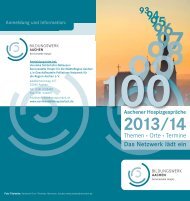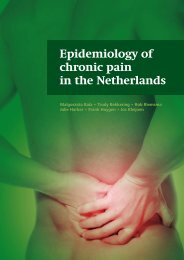First EFIC® Symposium Societal Impact of Pain - SIP
First EFIC® Symposium Societal Impact of Pain - SIP
First EFIC® Symposium Societal Impact of Pain - SIP
Create successful ePaper yourself
Turn your PDF publications into a flip-book with our unique Google optimized e-Paper software.
Villy<br />
Meineche-Schmidt<br />
Villy Meineche-Schmidt MD, DMSci<br />
The Private <strong>Pain</strong> Clinic<br />
Herlev, Denmark.<br />
SOCIETAL BENEFIT OF MULTIDICIPLINARY<br />
REHABILITATION IN CHRONIC NON-MALIGNANT<br />
PAIN PATIENTS.<br />
Patients are referred to The Private <strong>Pain</strong> Clinic, a<br />
multidisciplinary pain clinic in primary care, due to a<br />
‘waiting time guarantee’, i.e. patients have the right<br />
to choose treatment in private care, if public pain<br />
centers cannot <strong>of</strong>fer management within one month.<br />
As the waiting time in public pain clinics in Denmark<br />
exceeds one year many patients prefer this private<br />
alternative – the private clinic is obliged to see the<br />
patient within one month.<br />
Uncertainty about economy and future working capability<br />
is an important part <strong>of</strong> the bio-psycho-social<br />
complex <strong>of</strong> chronic pain. Some patients will have to<br />
reconsider their total life and many will not be able<br />
to go back to previous work. Multidisciplinary intervention<br />
thus, has to address psychological reactions<br />
and social complications along with pharmacological<br />
treatment. The aim <strong>of</strong> the intervention is to help the<br />
patient’s acceptance <strong>of</strong> future possibilities and limitations,<br />
focus on new aspects <strong>of</strong> life with chronic<br />
pain and realize that a process <strong>of</strong> grief may be necessary.<br />
An essential goal is to secure adherence to<br />
the labour market - if at all possible.<br />
Tailored for these patients we developed a Rehabilitation<br />
Program comprising 3 hours per day, 3 times<br />
a week for 13 weeks (120 hours). Each program has<br />
10 – 12 participants and comprises group sessions<br />
as well as individual sessions and sessions with participation<br />
<strong>of</strong> spouses and children. The following<br />
themes are covered: introduction to the bio-psychosocial<br />
understanding <strong>of</strong> chronic pain, anatomy and<br />
physiology <strong>of</strong> the human body, principles <strong>of</strong> physical<br />
training and warm water basin sessions, principles<br />
<strong>of</strong> relaxation therapy combined with personal training<br />
programs, psychological aspects <strong>of</strong> chronic pain and<br />
skills for optimizing the use <strong>of</strong> resources in daily living.<br />
Finally, social legislation in relation to the labour market<br />
and social security system and personal assistance<br />
in relation to the county is <strong>of</strong>fered. The staff in<br />
the program is primary care physicians, psycholo-<br />
gists, physiotherapist, relaxation therapists, social<br />
workers and nurses.<br />
In this presentation the economic status at the<br />
start <strong>of</strong> the program and at follow-up 9 months<br />
later will be reported for the participating patients.<br />
The economic impact for society and the<br />
cost-benefit <strong>of</strong> the program is calculated.<br />
A total <strong>of</strong> 117 patients attended eleven rehabilitation<br />
programs during 2007-2009.<br />
At the start 23 patients had work income and at follow-up,<br />
this was maintained by 19 patients, whereas<br />
three patients were on sick pension and one on rehabilitation<br />
benefit.<br />
90 patients were on transfer income at the start:<br />
thirteen on sick pension, 58 on sick leave, 12 on social<br />
benefit and 7 on rehabilitation benefit. Almost all<br />
patients on sick pension maintained this.<br />
Of 58 patients on sick-leave, 23 obtained work income,<br />
20 sick pension, 6 social benefit, 1 rehabilitation<br />
benefit – and the remaining six maintained sick<br />
leave.<br />
Of 12 patients on social benefit, 6 obtained work income<br />
and <strong>of</strong> 7 patients on rehabilitation benefit, 6<br />
obtained work income.<br />
The economic situation was concluded for 97 <strong>of</strong> 117<br />
patients (83%).<br />
The Danish social security system divides expenses<br />
between state and county in a complicated way –<br />
depending on the type <strong>of</strong> transfer income. As a consequence<br />
<strong>of</strong> the reported changes, state expenses<br />
increased by 540,000 Euro and county savings<br />
amounted to 698,000 Euro - annually. Thus, the societal<br />
savings were 158,000 Euro per year. Total<br />
costs for the rehabilitation programs amounted to<br />
421,000 Euro, thus resulting in balance between<br />
costs and savings after 2.7 years.<br />
The average time to age pension for the participating<br />
patients was 25 years.<br />
The potential accumulated savings thus amounted<br />
to more than 3 million Euros.<br />
Conclusions:<br />
Patient referral based on waiting time guarantee secures<br />
early intervention. Only 10 per cent <strong>of</strong> the patients<br />
who participated in the rehabilitation programs<br />
were on sick pension at the time <strong>of</strong> referral (compared<br />
to 60% in a Danish public pain center), which<br />
facilitates rehabilitation and return to the labour market.<br />
For patients with unclarified economy at start<br />
(sick leave, social benefit and rehabilitation benefit)<br />
76% were clarified at follow-up: 45% had work income<br />
and 31% were on sick pension.<br />
The program was highly cost effective: expenses for<br />
the program balanced savings after less than three<br />
years, while the average time to age pension was<br />
25 years. The potential accumulated savings per patient<br />
until age pension was 30,000 Euro.<br />
71






